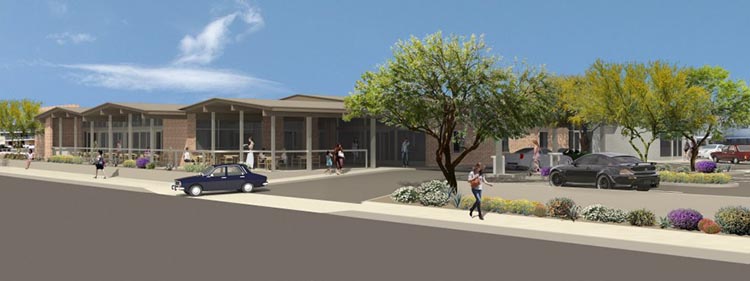Today’s post is by contributing writer Jennifer Gunther:
Thursday morning on the northwest corner of Camelback Road and 3rd Avenue in uptown Phoenix, the community was welcomed back to a place it hadn’t been able to open a door to or sit down in for seven years. An array of developers and local leaders ─ among them Lorenzo Perez and John Kitchell of Venture Projects, Shannon Scutari of Sustainable Communities Collaborative, Kimber Lanning of Local First Arizona and Phoenix city councilman Tom Simplot ─ announced the adaptive reuse of the locally beloved Beef Eaters restaurant building.
Being rebranded as The Newton in honor of Jay Netwon, Beef Eaters’ founder, Perez said the redevelopment project will introduce three new destinations for the community. Though the one being most talked about is what will be the second Changing Hands Bookstore location in the Valley, Perez revealed the other two uses for the old steakhouse restaurant. Changing Hands will be joined by Lively Hood, a shared meeting and event space for mobile, creativity-oriented professionals, and an eatery spearheaded by the minds behind the popular Beckett’s Table on 38th Street and Indian School Road. The entire project has an ambitious goal of opening by November of this year.
Kitchell said that Venue Projects, which is working on The Newton with John Douglas Architects, seeks to redevelop buildings that have character. He called reintegrating Beef Eaters’ legacy into the community an exciting opportunity.
“It’s an opportunity to renew a wonderful example of desert architecture and to celebrate the business deals done here as well as the community that gathered here,” he said.
The 1961 building is constructed of adobe brick from Queen Creek and features a vaulted post and beam ceiling, Kitchell said. An interior with oak paneling, walnut flooring, black leather booths and antique light fixtures awaited the developers as they surveyed the property and imagined a use that could capture the ambiance of the original restaurant.
“We love finding what’s worthy of being creatively put back into a place,” Kitchell told the attendees after describing the guts of building, which were able to seen on the construction site.
“Place” is the essence of the Beef Eaters that once was in addition to its new programming as The Newton. Straddling a concrete and abstract meaning, this simple word holds weight for Phoenicians who are dedicated to cultivating a more social and more sustainable environment downtown.
As Scutari juxtaposed past memories of evenings at Beef Eaters ─ including the time she watched a waiter mix a Caesar salad tableside with a raw egg cracked on it ─ with a litany of future activities people could take part in at The Newton, she reminded the audience of the importance of investing in the creation of places where people can connect with each other.
“Ten years ago, voters in Maricopa County decided they wanted real money to go for transportation choices so that people could get out of their cars or maybe not even have to own a one to get to the places they wanted to go to be with the people they wanted to connect with,” she said, touching on the wider, transit-oriented development goal of Sustainable Communities Collaborative (The Newton is within walking distance of the Central Avenue and Camelback Road light-rail stop). “We promised the voters we would deliver on that and turn their taxpayer funding into these kinds of places.” The Collaborative helped fund The Newton and supports similar projects along the entire 20-mile line.
Lanning, well-known for advocating small and local business through her Local First Arizona organization, said there is power in these organizations joining arms and putting their marketing dollars together to create a sense of place. She also brought attention to a more traditional aspect of economic development ─ job creation ─ and expanded its reach to the smaller supporters of projects like The Newton.
“It’s not just about the amazing job [the developers and architect] are going to do or the construction … it’s all the graphic designers and payroll service providers – everyone who supports it and is behind the scenes,” she said. “These companies are here and are rooted in the community.”
Economic development in Phoenix, particularly in its urban core, is becoming more about placemaking than it is about attracting large, mostly out-of-state businesses. It’s more so being explicitly based in the cultivation of an engaged community, something many Phoenicians believe was lost to the suburban sprawl that characterizes most of the Valley. The city’s social life and its need for a strong network of revenue-generating activity no longer seem to be exclusive choices for developers, city boosters and customers alike because of an increased investment in adaptive reuse, historic preservation and promotion of local innovation and creativity. The local character and social opportunities these developments have helped bring about are simultaneously enjoyed and capitalized on by everyone in one way or another, whether they are a developer or a neighbor.
As one woman said in all the excitement as people toured the site of the soon-to-be Newton, “Don’t you feel like you’re part of a community here?”
Photo Credit: Images Courtesy of The Newton.





















The project is certainly interesting and while I am ecstatic that the classic Beef Eaters structure will be adaptively reused, it would have been great to see some additional density as part of the project. The site is only 350 meters from the Central & Camelback METRO station and it would have been great to see some urban, transit-oriented, dense development on that site.
That being said, I do wish the project the best of success. Changing Hands and its neighbors are going to be great additions to that neighborhood and to central Phoenix.